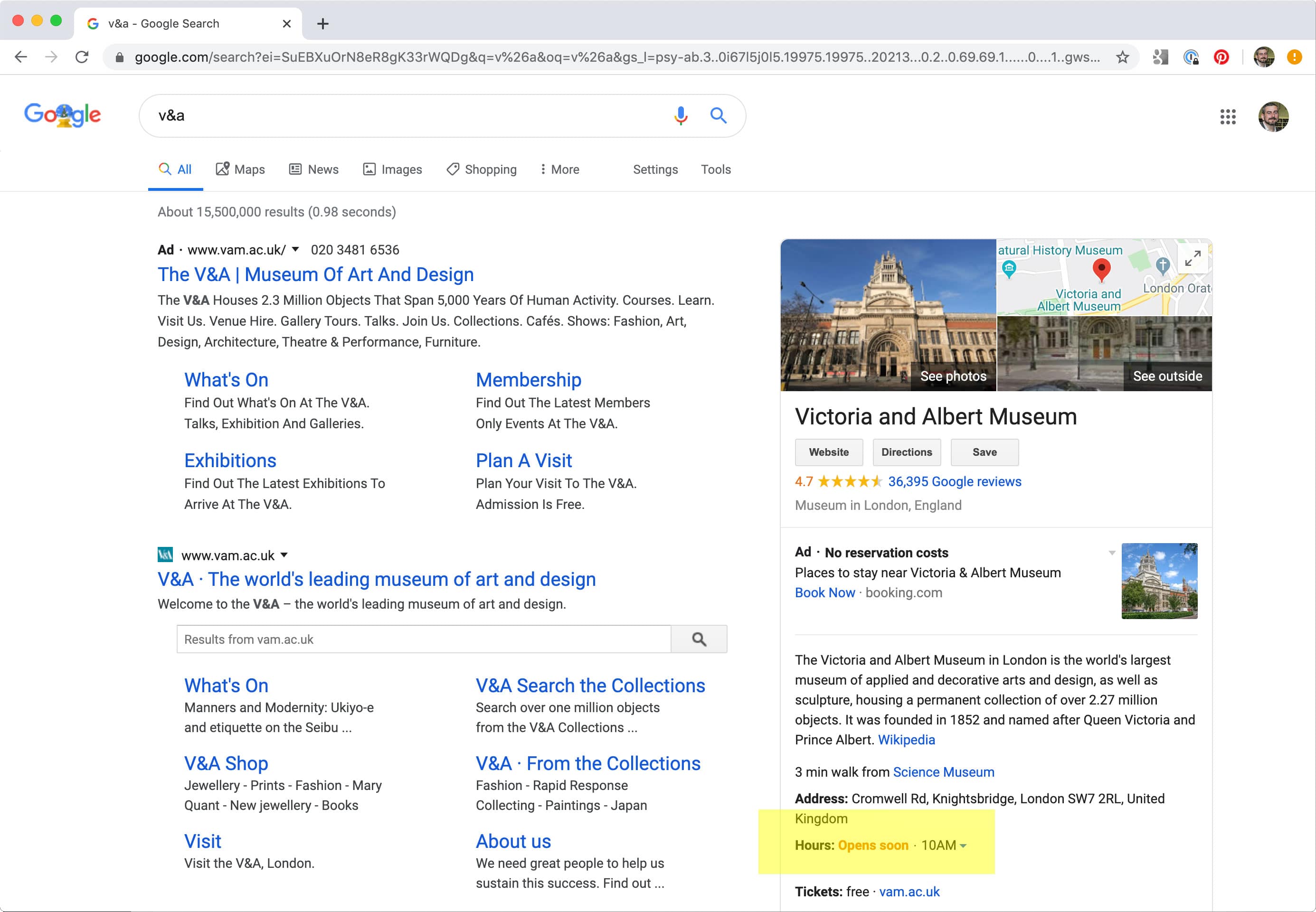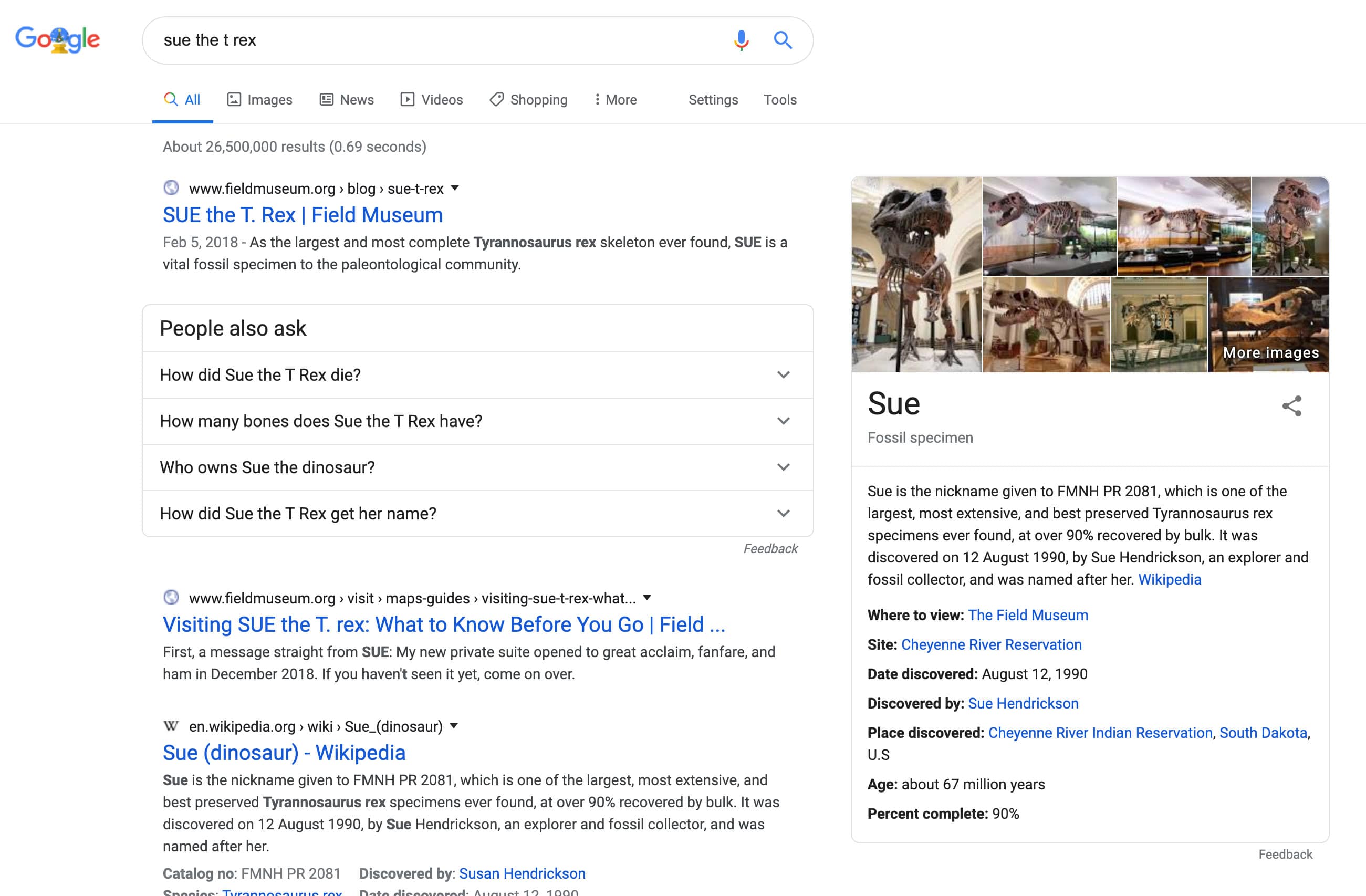Fresh ideas from museums around the globe in your inbox each week
As we launch into 2024, many museum marketing managers are likely to be asking the question, “How can SEO help my museum in the decade ahead?” While we don’t have a clear window into the next 10 years and can only guess at some of the many potential technological changes and Google algorithm updates to come, we can make some predictions for what to anticipate based on certain rising trends that aren’t going anywhere anytime soon.
SEO (Search Engine Optimization) is the practice of optimizing content to be discovered through a search engine’s organic search results. For museums with limited budgets, having a website which features in organic search results (rather than Google Advertising) is a cost effective way to get exposure for your museum and a great way to serve your audiences.
Afterall museums are subject matter experts. So when a member of the public has a query about art, science or history, it makes sense for a museum to be there with the answer. For many museums, being the top search result is inline with their educational missions.
The following SEO trends will not only effect museums in 2024, but will help shape the future of search in the coming years.
The most important thing for museums to keep in mind when optimizing their websites for Google in 2024 is user intent. SEO is no longer about simply writing lots of content with dozens of keywords in hopes that Google will see you and rank your pages favorably. Google wants to know that your pages are what users truly want.
So, before we get into the specific trends extending from this, you should always remember that the user comes first, not the search engine. The more helpful and engaging your content, the better it will perform in the long-term. This is good news for museums as trusted content experts.
With the recently developed ability for users to find the answers to their questions directly on the Google search engine results page, people no longer need to click to a specific webpage for additional information, particularly if their questions only require brief one or two sentence answers.
For example at one time finding a museums opening times required visiting their website, however now Google provides that information on a feature snippet. That means less people clicking through to museum websites and more basic information covered on the search results page.
Feature snippets aren’t limited to visitor information. For example the image below shows the search result for “Sue the T Rex”. This is the most complete Tyrannosaursaurus Rex skeleton ever found and is one of the must see exhibits at The Field Museum in Chicago.
While the museums page about Sue the T Rex comes first in the search results, Google also features a Wikipedia page about the dinosaur. This Feature Snippet undoubtably attracts clicks which would have once gone to the museums page.
Featured snippets are unlikely to disappear as they give search engine users an efficient and convenient way to find the answers they’re looking for as quickly and easily as possible. Museum Marketers may see this as an inconvenience on their end because this feature keeps actual search results requiring clicks from appearing near the top of the page, requiring users to scroll down to see them.
While it’s true that featured snippets have been around since 2013, they’ve gone through some changes that keep them prominently featured in search results. Snippets can feature more than just simple text excerpts, as they’ve developed to include translations, calculations, dictionary definitions, and pricing tables, among other bite-sized media.
Google selects and shows featured snippets by scanning web search listings using an automated process. The system decides which snippet would be most useful based on the query and highlights the most relevant one it can find. Snippets are far more likely to appear for users who enter questions as queries.
Museums can’t automatically indicate to Google that any text on a webpage is intended for snippets. Instead, the best way to appear in snippets is to find the most commonly asked questions among your museums audiences and provide concise, succinct answers that Google’s algorithm may favor.
Rich snippets are another type of snippet to keep in mind; think of them as companions to featured snippets. Rich snippets don’t appear as high in search results as featured snippets and are used to show additional information and relevant links below a specific search result.
Some rich snippet content could include additional links to a website, pricing charts, product reviews, recipe ingredients and metrics, details about a specific song or album, and many other types of information.
You can optimize your museums website for rich snippets, unlike featured snippets. You can do so by including all relevant information in your webpages’ metadata and Schema code, which will help indicate to Google what the page is about in specific details that it can include in those small rich snippets.
If your website is built on WordPress, there are plugin’s to help you to structure your data for rich snippets and manage your Museums SEO.
Another big development to keep in mind that will influence both featured and rich snippets, among other results for search queries, will be something called Bidirectional Encoder Representations from Transformers (BERT).
Google introduced BERT as a new neural network-based method for natural language processing pre-training. Put simply, this algorithm update helps maximize the relevancy of search results based on search intent behind each query.
The “bidirectional” element means that BERT looks at a search query for context by scanning phrases both from left to right and right to left to maximize accuracy, whereas other natural language processing pre-training systems have only looked at language in one direction, from left to right, to determine intent.
As a result, BERT allows Google to more effectively decide which search results are the most relevant based on users’ queries. If you want your museum website to appeal to BERT, you’ll do well to perform some Google searches of your own when researching topics for content and looking for some frequently asked questions that feature answers in the featured snippets.
More and more people are relying on mobile devices for performing searches, and will only continue to do so well into the next decade. Google’s emphasis on mobile-first indexing isn’t anything new: In 2016, they announced that they would be focusing on indexing for mobile search first, and by July 2019 they completed the rollout.
Mobile-first indexing means that museum websites should always be mobile-optimized. If your website is mobile-friendly and well-optimized, you’ll have a much better chance of appealing to mobile users when they perform a search. A mobile-optimized website will also prevent people from leaving due to poor visibility of content or navigability across your website using a smartphone, tablet, or another mobile platform.
So this isn’t just about SEO for your museum, it’s about better serving your audiences.
Another big change we’ve recently seen and which will only be even bigger as the decade goes on is voice search. Millions of users already use devices like Google Home, Amazon Echo or Alexa, and Siri to make performing searches easier than ever, and we can only expect that number to increase.
Voice search will provide users with results based on searches given in the form of questions, which you can attempt to optimize for by doing what you would for featured and rich snippets: Simply answer some of those questions that people are likely to ask using voice search with relevant answers that Google will likely favor.
This seems particularly relevant to museums, which as content experts are in a good position to answer these kind of queries. These queries are likely to be about your collections or the subjects that you cover and less likely to be about opening times or exhibition tickets.
Ultimately, the most important step to take when optimizing your museum websites SEO for the future is to gain a good understanding of your audience’s needs and, through those, their language. The more you appeal to what they’re looking for and how they’re looking for it, whether it’s in the form of a vague search phrase or a specific question via voice search, you’ll have a better chance of staying above your competitors.
As content experts Museums are well placed to deliver the kind of high quality content that Google values. Museums should view providing SEO friendly content not only as a good marketing exercise, but also as another route to deliver on our educational missions. All SEO takes is a little work from the museum to create the right content and structure this correctly. Then search engines will do the rest.
Does your museum prioritise SEO? How has your museums approach to search engine optimization changed over the past few years?
Manuel Charr is a journalist working in the arts and cultural sectors. With a background in marketing, Manuel is drawn to arts organizations which are prepared to try inventive ways to reach new audiences.
Understanding how to navigate the complex world of Search Engine Optimisation (SEO) is vital to any museum or cultural venue looking to expand reach and…
According to Livdeo, a French tech company that provides inclusive digital solutions for cultural institutions, the digital collections should be accessible to everyone, regardless of…
What does the future of digital collections look like? Terentia recently hosted a panel discussion as part of the MuseumNext Digital Collections Summit to discover…
Fresh ideas from museums around the globe in your inbox each week
© MuseumNext 2024 | Terms and Conditions | Privacy Policy




